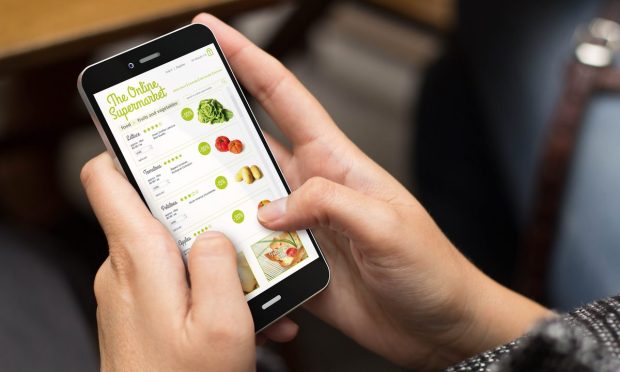Grocers Grapple With the Economics of Smaller, More Frequent Digital Orders

The majority of consumers may continue to prefer shopping for groceries in stores to shopping online, but those who have adopted eGrocery options are integrating the channel into their regular routines, shopping more often.
This shift poses challenges for grocers, with smaller purchases leading to trickier unit economics, but it also creates an opportunity to build deeper and more lasting relationships with customers as their overall spending on online grocery increases.
“We’re now starting to see people going away from their traditional weekly shop to more of a periodic shop. …. Smaller baskets more frequently is the fundamental change that we see within eGrocery,” Kevin Price, senior consultant at multinational logistics automation company Swisslog, told PYMNTS in an interview. “It makes [the economics] a little bit more difficult for [grocers] really. The scale and preparation of an order is always a benefit for a retailer — the more you do, the bigger you get. … It does make it a bigger challenge for a retailer to be able to get multiple small units out to a customer.”
He added that, as consumers shift to smaller, more frequent trips, they are spending about 10% more on average overall.
Stocking the Shelves
Consumers’ shift to more frequent purchases increases grocers’ labor needs, especially when it comes to delivery orders, leading to greater demand for automated solutions. Price noted that automation is playing a key role in making the picking and packing processes more efficient, especially when retailers complete the process in fulfillment centers outside the store.
Plus, the economics of grocery delivery have been difficult from the start. Even brick-and-mortar grocery is a business with notoriously narrow margins. Adding the labor cost and logistical challenges of delivery exacerbates the issue, driving up grocers’ desire for robotic alternatives.
Additionally, Price said automating behind-the-scenes eCommerce processes enables retailers to communicate better with their customers.
“Taking the technology into automation systems gives you greater visibility over the stock, the control, you don’t have the external influences of customers coming in,” he said. “So, you’re able to give your customers a lot more visibility and a lot more confidence about … product availability.”
In fact, inventory is a key consideration for more than half of all grocery shoppers, according to data from Decoding Customer Affinity: The Customer Loyalty to Merchants Survey 2022, a PYMNTS study created in collaboration with Toshiba Global Commerce Solutions. The report, which featured the results of a survey of a census-balanced panel of more than 2,000 U.S. consumers conducted in the late fall, noted that 51% of consumers say that, if a merchant ensures that grocery products are in stock and available to buy, it improves their loyalty to that grocer.
Get the full report: Decoding Consumer Affinity: The Customer Loyalty To Merchants Survey 2022
Additionally, about 1 in 6 consumers (18%) now buy groceries online more frequently than they buy in stores, the study found and that digital features can boost customer loyalty. Twenty-three percent of shoppers reported that online purchasing capability would make them more loyal to their grocery merchants, and 20% said the same of product delivery.
The Price Is Right
Going forward, Price believes that, in markets where online grocery adoption is higher than it is in the United States, grocers need to make better use of under-filled delivery slots, incentivizing drop-offs at off hours with discounts or with flexible windows.
“There’s usually quite a lot of slots that aren’t taken up, and [there’s] opportunity to incentivize people to use those spaces away from the prime slots,” he said.
Such initiatives would allow grocers to get more value out of their existing fulfillment networks and to meet more demand.
Financial incentives could go a long way. The Decoding Consumer Affinity study found that price is the number one factor cited by grocery shoppers as the main consideration influencing their choice of merchant. Additionally, 77% of consumers stated that low prices would improve shoppers’ loyalty to their grocery margins, and 52% said the same of promotions and discounts.
Brick-and-Mortar Innovation in Digital Stores
As online grocery continues to take hold, Price expects that grocers will increasingly integrate the channel into their operations, treating it as a core part of the business rather than simply an add-on to brick-and-mortar.
“eGrocery at the moment is very much the baby brother or sister, and I think that we will rapidly move towards a point of parity,” he said. “People are talking [eGrocery accounting for] 50% [of all grocery] in 10 years’ time.”
He predicted that digital and physical channels will “become twins,” rather than remaining “younger and older siblings.” Additionally, as this shift happens, he expects grocers to begin treating their online presences with the creativity seen in physical stores.
Online grocery “will be the place where most of the innovation will come through, and the principles of surprise and delight for customers and everything like that that we saw coming into retail stores — that will be driving a lot of innovation,” he said. Grocers will think about “how you can bring the product closer to the customer in a virtual world … making a virtual experience closer to the traditional retail experience that we see going forward.”